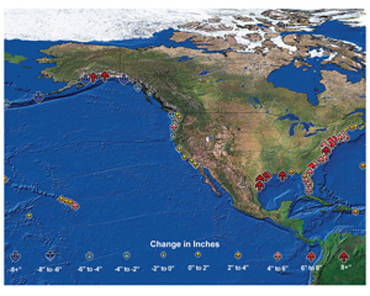Over the next few decades, some of the country’s most expensive property is likely to either get a lot more expensive, or to disappear beneath the waves — a victim of rising sea level.
Sea level is rising as a result of Earth’s warming climate. Higher temperatures melt the glaciers in Greenland, the Antarctic, and elsewhere, adding more water to the oceans. And as the oceans get warmer, the water expands, boosting sea level even more. Sea level increased by about six to eight inches during the 20th Century, with rises of several feet predicted for this century.
 Observed changes in sea level relative to land elevation in the United States between 1958 and 2008. Credit: U.S. Global Change Research Program
Observed changes in sea level relative to land elevation in the United States between 1958 and 2008. Credit: U.S. Global Change Research ProgramIn some countries in Southeast Asia, where much of the population lives along the coastline, rising waters are likely to cause mass migrations, as residents are forced to move to higher ground. And some of the island-states of the western Pacific Ocean may vanish entirely.
More-developed countries are more likely to use technology to protect coastal cities — something that’ll cost many billions of dollars.
Even so, American coastlines are likely to see big changes. Higher sea levels will erode beaches and wash away some of their protective barrier islands. They’ll contaminate groundwater supplies with salt water, and wipe out wetlands that protect the coast from storm surges. The loss of wetlands will also deprive many species of birds, fish, and shellfish of their homes. That’ll create massive impacts not only on the natural world, but on many coastal economies.
We’ll talk about the impact on one region in our next program.

